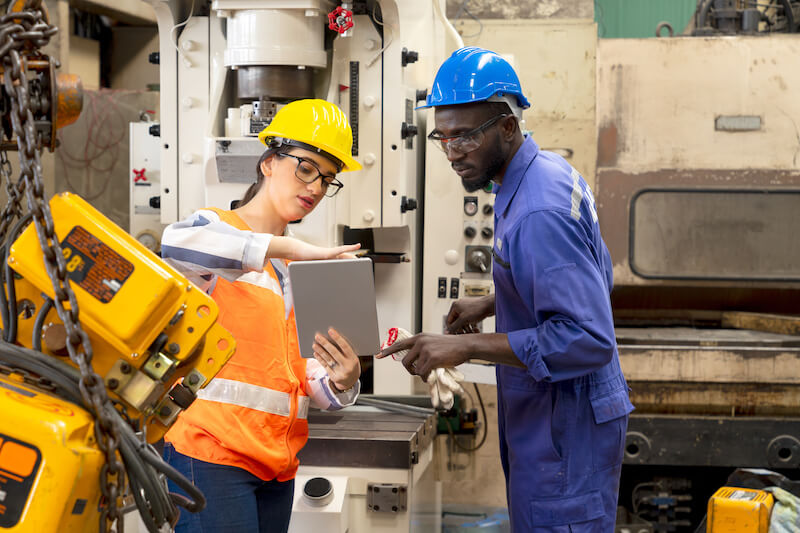The ins and outs of a manufacturing business are complex. Worker safety, production deadlines and intricacies, the scope of maintaining the correct manufacturing equipment and supplies, and cost management and efficiency. Ultimately, manufacturing operations managers and leadership are focused on streamlining their operations to ensure that everything that occurs on the manufacturing floor is as efficient and cost effective as possible With the onset of COVID-19 in 2020 and the strain that put on supply chain and manufacturing resources, operational efficiency has now become even more critical for the manufacturing floor.
A critical investment manufacturing leadership can make is that of investing in streamlined operations with technology. The more efficient and productive your operations can be, the quicker you can scale your business and the more profit you and your team will take home. There are many ideas out there as to how best to streamline operations and run a more productive and cost effective business. One concept that has emerged in the fourth industrial revolution, or industry 4.0, as a key way to invest in streamlined operational processes is by focusing on the connected workforce.
The Connected Workforce
Considering streamlining operational efficiency and moving to more digital strategies and focusing their industry 4.0 initiatives, it might first make sense to automate more on the frontline. According to a recent Kearney report, Human workers are still performing 72 percent of manufacturing company tasks. In addition, human workers generate three times more actual value on the shop floor than the machines do, even though the machines are now critical to operations on a large scale.
With the research showing that human work is the dominant force on the manufacturing floor, technology can be used to enhance, streamline, and expedite that man-power. The same study from Kearny uncovered that 1/3rd of manufacturing workforce manpower is spent on manually gathering data to analyze. The actual analysis of that data isn’t even a part of that effort. From this figure alone, it’s clear that some sort of streamlined operation around automated data collection would save manufacturing leadership time and money.
The connected workforce, partnering technology with human skill and intelligence, is the key.
Streamline Manufacturing Operations
Investing in a connected workforce, in general, is a critical move for manufacturing leadership to make. More specifically, investing in technology alongside human work and skill is a surefire way for manufacturing leadership to streamline operations. Streamlining manufacturing operations with the connected workforce will most benefit manufacturing leadership’s operational output in 3 key ways:
- Data Collection – by utilizing technology to collect frontline information, instead of traditional paper forms or delayed reporting by team members, the effort of teams to manually collect and even accurately input data is a thing of the past. With data collection being automated, workers daily tasks can be more focused on executing good work and not on clerical tasks. The element of human error disappears with technology being used to capture and secure data most critical to the success of the business. Utilizing a connected workforce tool to collect data also allows that data to stay secure and consistent even as workers come in and out of the business. It also allows new employees to have access to a rich history of data around the companies operations and efficiency.
- Data Analysis – Just like data collection, data analysis takes a significant amount of human time and energy if done in a completely manual way. A connected workforce technology can help analyze said data much faster than manual human work can. AI and connected technology can take data analysis and prompt suggestions, results, next steps and more to the broader workforce, allowing human workers to do what they do best and stay focused at effectively executing their tasks with the power of data keeping them on track and in the right direction.
- Worker Safety and Communication – If all workers are more efficiently collecting and recording data in a standardized way, actioning and executing off of that connected data, than communication and in-turn worker safety will greatly benefit from a connected workforce. When workers can be focused on performing the tasks they were hired to do and have more time in their day to do those tasks well due to data collection and analysis being automated, communication will naturally improve as all workers are executing their jobs off of the same unified data. More data and more connection informing decisions will improve safety, and a safe work environment is truly the best way to save all resources, time, manpower, and money, and streamline operations.
Manufacturing leadership needs to consider streamlining operations through connected workforce solutions to achieve efficiency and productivity results or they will be left behind in industry 4.0.
Anvl Can Streamline Your Operations with a Connected Workforce
Interested in learning more about how Anvl can streamline your operations with a connected workforce? Anvl can digitally transform processes like general work instruction, audits, permits and more to help guide workers in-the-moment and capture critical data. Learn more to See Anvl in Action and contact one of our experts today.


